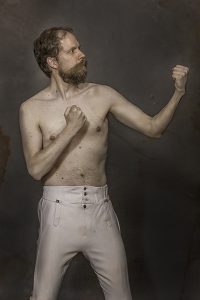As a specialist portrait photographer passing on this knowledge is directly useful to others as shooting portraits is a great way to earn extra money if you are a part-time photographer, it’s also a very healthy market for semi-pro and pro photographers.
I’ve been teaching quite a lot of photography recently, I’ve always enjoyed passing on my knowledge and experience to others, especially photographers who are just starting off their careers.
Think of it, we live in a visual world, just about everyone has a photo up on the internet, whether it’s Facebook, LinkedIn, Twitter or any number of other sites. It could be their website or a profile picture, the point is as we live in a visual world and a photo allows viewers to create an instant impression of you – so the right picture is crucial.

Prizefighter Portrait
During one of my recent teaching workshops I used the opportunity to shoot a job for a client, thus showing the student the whole process from the creative brief, the pre production, the set up, posing and the photography process. Then we worked through the post production side of things, choosing the final images for the client to view and carried on to the editing process and finally the retouching of the finished image.
The photo turned out exactly as I had envisaged, most importantly of all as a professional portrait photographer the client was thrilled with the result. It was great fun to shoot but the best bit was helping other photographers understand the whole commissioning and delivery process on a professional commission.
As a bonus to the groupI I also shot another portrait on the same set using different lighting where the model was dressed as an Edwardian Gentleman, this allow them to see another style of portrait using a stove pipe hat. The importance of this was encouraging students to understand how the addition of a hat could cast shadows across the models face and indeed sometimes completely obscuring the eyes.
Getting students actively involved in the lighting set up makes them thnk for themselves, recognise the variations a change of light or attire can cause and overcome the issues that arise during a shoot when the pressure is on.
